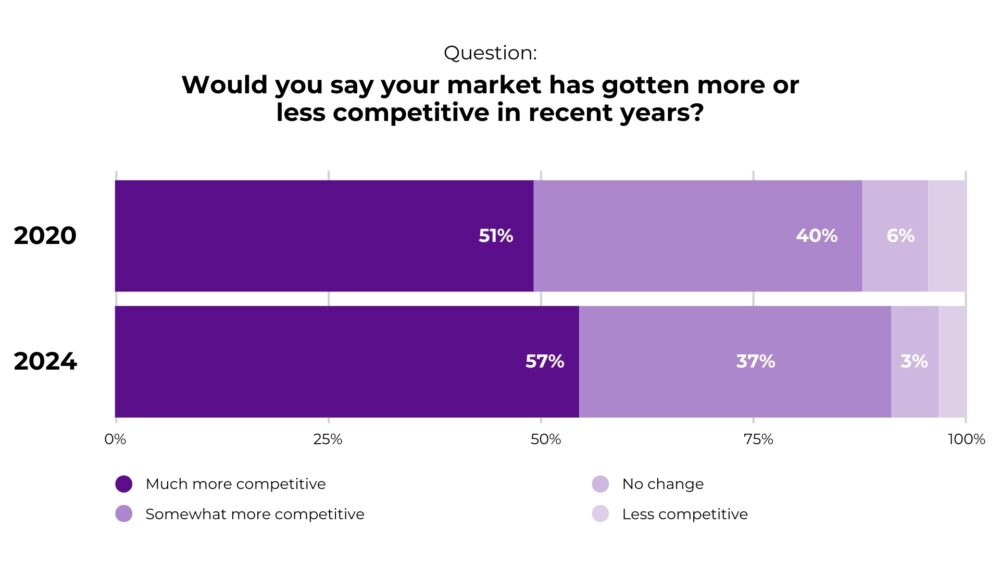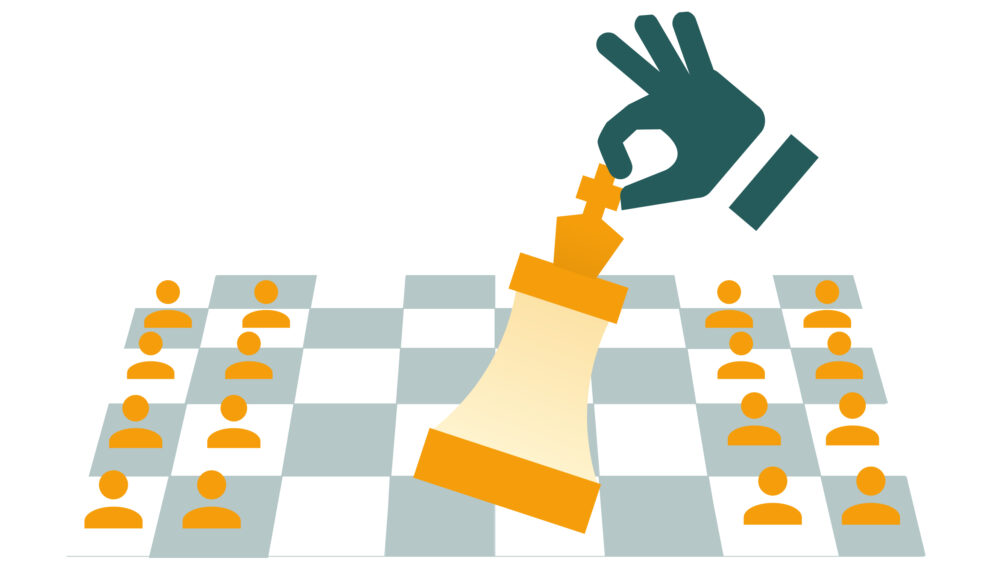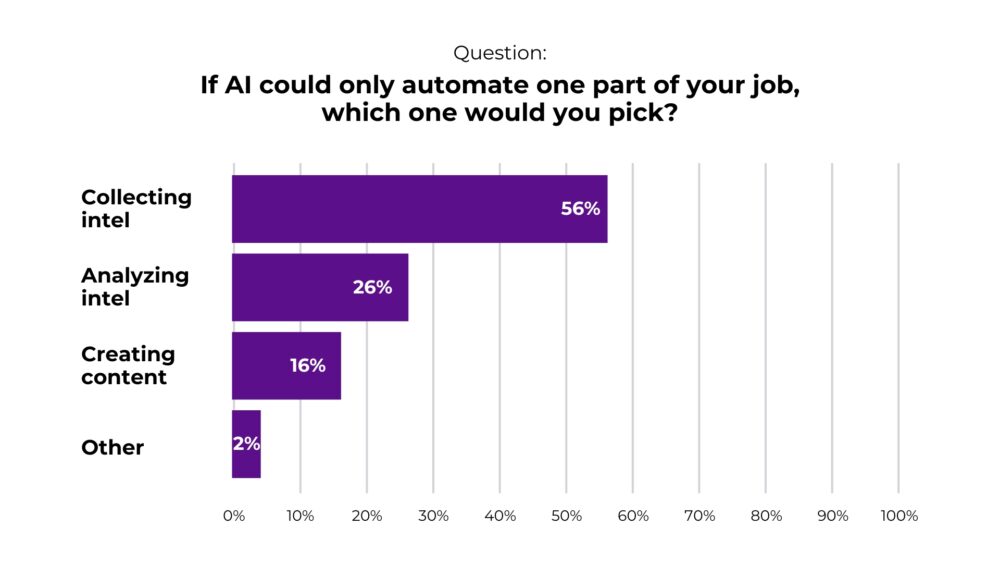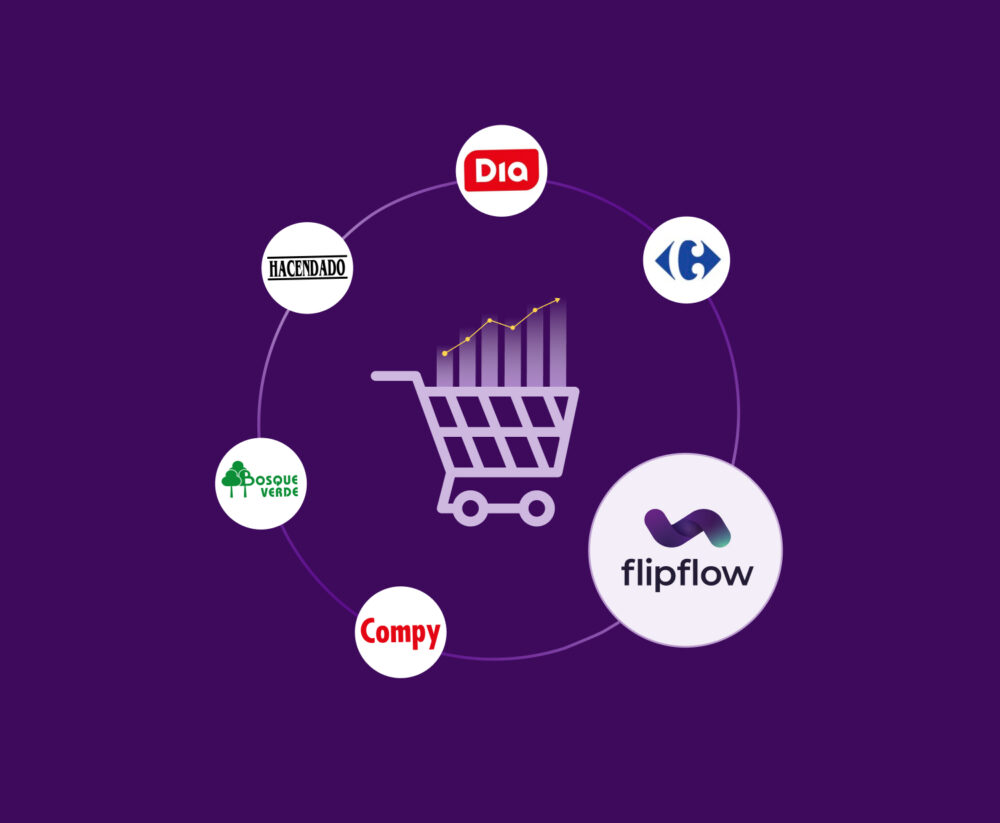Speed is Key: How to Stay Ahead with Competitive Intelligence
Over the past four years, market competition has only intensified. According to Crayon’s “State of Competitive Intelligence 2024” report, 57% of leaders in this field say the market is much more competitive now, compared to 51% who felt the same in 2020.
Source: 2024 State of Competitive Intelligence – Crayon
In this scenario, competitive intelligence becomes a vital process for any business that wants to stand out. Speed in decision-making and constant information updates are essential in a world that, as we can see, is constantly changing.
In this post, you will discover that speed can be competitive intelligence’s best friend and how to leverage it to improve your business strategy.
Introduction – What is Competitive Intelligence and Why is it Crucial Today?
Competitive intelligence is defined as the ability to gather, analyse and use information about competitors, customers and other market factors that contribute to a company’s competitive advantage. In essence, it is about understanding the business environment to discern what is happening, what will happen and what it means for the organisation.
This translates into more informed decisions and a strategy fully adapted to the market. Businesses of all sizes can benefit from this process, as it improves the planning and execution of commercial strategies.
The digital age requires us to act quickly. Information moves in real time. Therefore, speed is a key factor in order not to be left behind. Here’s why.
Why Speed is Key to Staying Ahead: 3 Fundamental Reasons
In today’s dynamic business landscape, markets evolve rapidly, and opportunities appear and disappear in an instant. Speed becomes indispensable.
The ability to react quickly to information and to implement actions based on the data obtained provides a competitive advantage in multiple ways. We explain which ones:
1. First-mover advantage
Being first to act is always a significant advantage. When a business makes quick decisions based on up-to-date information, it can get ahead of its competitors.
- Capturing opportunities: By identifying a trend or a change in the market, the business can develop strategies to take advantage of the situation.
- Innovation: Speed fosters creativity. Ideas are executed before the competition, which generates innovation and positions the business as a leader.
- Customer trust: Customers value responsiveness. A business that acts quickly gains a reputation and builds customer loyalty.
The first-mover advantage is not just about being the first to obtain information but about being the first to offer relevant solutions, at the right time, based on the data obtained.
2. Responding to market changes
The market is dynamic. Changes can occur overnight.
- Flexibility: The ability to adjust strategies according to new conditions is essential for survival.
- Anticipation: A quick response allows for changes to be anticipated and the business to be prepared for any eventuality.
- Competitiveness: Businesses that react immediately can capitalize on emerging opportunities and avoid threats.
Speed in decision-making allows businesses to adapt and lead market evolution. This capability is increasingly valued in a globalized and digital business environment.
3. Removing bureaucracy
Bureaucracy is the enemy of speed. Overly formal processes and long approval chains can stifle an organisation’s ability to respond.
- Agile decision-making: A flexible organizational structure allows decisions to be made quickly and effectively.
- Less time wasted: By eliminating unnecessary steps or lengthy waits for information from large market research consultancies, the business saves time and resources.
- Continuous adaptation: Lean structures facilitate change and adaptation to new circumstances.
Removing bureaucracy involves simplifying processes and fostering team autonomy. This helps information to flow quickly and decisions to be made without unnecessary delays.
Risks of Slow Decision-Making
Delays, both in decision-making and execution, can be very costly. According to a survey by the Economist Intelligence Unit, the longer it takes to make decisions, the greater the revenue opportunities that are lost.
The survey revealed that the longer it takes businesses to make decisions, the greater the risk of lost revenue. Those companies that managed to make a decision in a day or less were 40% more likely to have increased their revenue by 10% or more during the last fiscal year, compared to those that took longer.
Below, we explain some of the risks associated with slow decision-making:
Risk of obsolescence
The world is moving at a rapid pace. Lack of agility can leave a business behind.
- Outdated technology: A slow-moving business may be using tools and processes that are no longer effective.
- Loss of relevance: Customers seek modern and up-to-date solutions. If a business doesn’t adapt, it loses ground to the competition.
- Outdated strategies: Strategies that worked a few years ago may not be effective today.
Obsolescence is a constant risk. Staying up-to-date requires a proactive mindset and the use of modern tools that help to analyse the market in real time.
Market myopia
By acting slowly, businesses can become so focused on internal matters that they lose perspective on the market. This lack of external vision can have serious consequences:
- Ignoring new industry trends: By not constantly monitoring the environment, it is easy to overlook changes in consumption habits, technological innovations or new business models.
- Failing to detect competitor movements: If the competition isn’t closely observed, it’s likely that their strategies, launches or changes of direction will be unknown, preventing timely reaction.
- Missing emerging opportunities: Slowness limits the ability to identify and take advantage of new opportunities, such as market niches, strategic alliances or innovations that are still little exploited.
Organizational paralysis
Slowness can lead to internal blockages. When decision-making is delayed, the business can fall into organizational paralysis.
- Lack of direction: Uncertainty and delay can create confusion among employees.
- Postponed actions: Excessive waiting can lead to important decisions being postponed, affecting operations.
- Decisions based only on internal data: Focusing only on internal metrics can lead to incorrect or out-of-context decisions.
An agile organisation avoids these blockages and creates an environment where each member feels empowered to act immediately in response to change.
Information overload
The constant flow of information can be overwhelming. Slowness in data analysis can lead to information overload.
- Confusion: When there is too much data without adequate analysis, there is a risk of making decisions based on irrelevant information.
- Delayed response: Information overload can hinder the ability to respond.
- Loss of focus: The business may lose its way if it doesn’t filter and prioritize critical information.
It is fundamental to have systems and methodologies that allow information to be managed efficiently and quickly. This will help transform data into sound decisions without falling into saturation.
Factors that Enhance Speed
For a business to make agile and effective decisions, it’s not enough to want to do things quickly. It is fundamental to build a solid foundation that favours speed. This involves working on different fronts within the organisation: from culture to processes and technology. All these elements are interconnected and, if well-aligned, allow for rapid responses to environmental changes.
It all starts with organisational culture.
This is the foundation that drives how people think, act and make decisions within the business. A culture oriented towards change and innovation allows for better adaptation to challenges. Fostering a change mindset helps teams to be more open to new ideas and proposals. In addition, employee empowerment is key: when people feel responsible and empowered to act, delays caused by rigid hierarchies or endless approvals are eliminated. In addition to this, open and transparent communication between departments allows information to flow quickly, which speeds up decision-making and avoids misunderstandings.
However, an agile culture needs to be accompanied by processes designed to facilitate speed. Flexibility in planning is fundamental for adjusting course without creating blockages. And continuous feedback ensures constant improvement based on real data and team experience. These processes not only reduce times but also improve the quality of decisions made.
Technology, in turn, plays an essential role in this ecosystem.
In an environment where information is power, having tools that accelerate data collection and analysis is a huge advantage. The use of specialized analysis tools allows trends, market behaviours and competitor movements to be detected in near real time. On the other hand, process automation significantly reduces manual effort and accelerates the execution of routine tasks.
In the Crayon study mentioned at the beginning of this article, another point raised by the leaders in Competitive Intelligence was the need for AI to assist in intelligence gathering, a task that is still excessively manual. This would leave them with considerably more time to analyse data and implement action plans:
Source: 2024 State of Competitive Intelligence – Crayon
And no less important is connectivity, as digital platforms facilitate collaboration between teams, regardless of physical location, allowing for more agile coordination and more informed decisions.
Examples of Businesses Benefiting from Speed in Competitive Intelligence
Numerous businesses have demonstrated that speed is a decisive factor for success.
The airline industry offers a clear example of how speed in competitive intelligence can generate significant benefits. Airlines constantly adjust their air ticket prices based on external information such as changes in prices on routes offered by competitors. The ability to react quickly to these price fluctuations is fundamental for maximizing revenue and maintaining competitiveness in a highly price-sensitive market.
E-commerce giant, Amazon, is another clear example of a business that benefits enormously from speed in competitive intelligence. It uses real-time price monitoring to dynamically adjust the prices of its products, ensuring it offers competitive prices and maximizes its sales in an online market where speed and accuracy are fundamental.
It’s worth highlighting how businesses already working with flipflow benefit when obtaining real-time competitive intelligence data.
One of the best examples of this is Grupo Lala. This large Mexican dairy multinational has managed to reduce execution time for cross-referencing information by 98%. For example, data analysts in its Sales Department previously spent around 4 hours a day cross-referencing all the available information to produce their reports. With flipflow, they can obtain these reports in just 2 minutes.
The time spent by Category Managers understanding the competitive situation and the performance of their products in the market has also been drastically reduced. They have gone from having to wait for reports for several days to being able to view them on a single panel whenever they need to. This has allowed for the rapid detection of new competitor launches or out-of-stock products, leading to a much faster and more agile reaction.
These cases show how speed in competitive intelligence translates into innovation, leadership and market success. Businesses that adopt this philosophy and use competitive intelligence tools such as flipflow are better positioned against the competition and are prepared to face environmental challenges.
Conclusion: Competitive Intelligence as an Ongoing Process
Throughout this article we have seen that competitive intelligence is neither a one-off task nor limited to data collection. It is a strategic and dynamic process that, when well-executed, can make a real difference in a company’s competitiveness. Its value lies not just in the information but in the ability to analyse it quickly and transform it into action.
Today, staying ahead in the market means being constantly alert: identifying signals, interpreting changes and making decisions without delay. Speed is the common thread linking all these stages. Without it, even the best strategies risk becoming obsolete before they are implemented.
Digital transformation has forever changed how we manage information. Investing in tools that automate processes and analyse data in real time is no longer an option but a necessity. This agility accelerates decision-making and improves the ability to anticipate the competition.
And best of all: competitive intelligence isn’t exclusive to large corporations.
SMEs can also benefit from it, applying simple processes and using accessible tools. The important thing is to start, adapt and constantly move forward.
Of course, the path to an agile organisation is not without obstacles. Resistance to change is one of the most frequent. However, as shown by the examples of leading companies we have analysed, taking the step towards a culture based on speed and adaptation is worthwhile. The benefits far outweigh the initial difficulties.
Competitive intelligence is, in essence, a living process. It’s not enough to implement it once and leave it on autopilot. It requires continuous review, strategic adjustments and openness to new technologies. Only then does it become a sustained advantage, not a passing fad.
Because in a market that never stops, every day counts. And those who act with speed don’t just survive: they lead.








